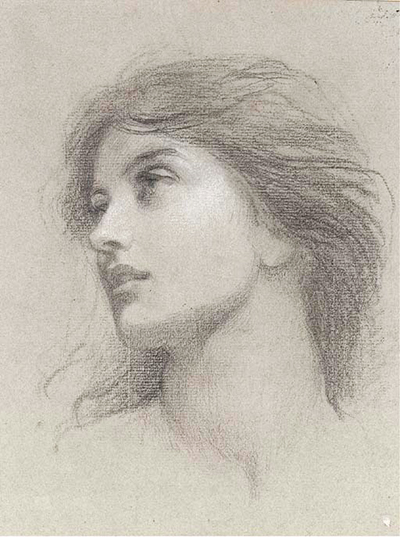Frank Dicksee was a highly skilled draughtsman who received considerable training in this discipline in his early years and he also continued to fine tune his talents over the full length of his career.
This was an artist who is highly regarded as an illustrator, not simply a painter. There are many sketches that have been uncovered from his career which focus on different elements of his later paintings, perhaps a single figure or facial pose. This period of British art was devoted to the female form and most notable artists of this era were classically trained at the Royal Academy, where they would have received the finest tutoring across a variety of mediums. Drawing would normally have been brought in early on, as it provided a basis to so many other related artistic disciplines. As a result, you may well see some similarities between the drawings of this artist and other related names from around this period, such as Waterhouse, Millais and Holman Hunt. They all fostered a charm and sophistication within their drawings, but some were completed in greater detail than others, depending on the precise requirement at the time.
There was a certain look which was particularly popular with British artists at around this time, generally being pale skinned, very slim young women whose faces appeared pure. This suited the romantic approach of the Pre-Raphaelites, as well as a number of other artists who worked somewhere on the fringes of their own group. Many would reuse the same models on several occasions, as well as allowing other artists to also hire their services. Their would also be genuine relationships created out of these meetings and these artists were particularly sociable in the main, and liked to spend time in each other's company. These women would bring much of the charm to this group and was a major part of their success, alongside the intriguing topics used to theme each work, normally inspired by literature from the past and present.
The photograph that we have included in this page is a study drawing completed by Frank Dicksee for his later painting, Chivalry. It was completed in pencil and white chalk on grey paper, which is common for most of his work in this field. He would sometimes work on loose pieces of paper, and on other occasions from notepads, before removing individual sleeves if a drawing was particularly good or important. This particular piece measures 9¾ x 7½ in and was sold at auction for £40,630, which is a particularly large sum for a Dicksee drawing - some of his paintings have received valuations in the millions, but less so his work as a draughtsman. The sketch itself is particularly beautiful, finished to a high level in terms of quality and also the level of detail, and also is still in good condition, hence the high valuation. It's connection to a later painting also provides a stronger context to the work.
The art form of sketching has allowed members of the public to purchase original artworks from some of their famous artists, when normally the oil paintings would be prices out of their reach. There are also often a large supply of these, finished to varying levels of detail. Some collectors would add them alongside the related painting if at all possible, and there is also a continued increased interest in British artists from this period both in the UK and also across in the US. The innocence of these women, as appeared on paper, brings an element of charm which some feel has been lost in today's modern society. In the same way, his own career would come under criticism for being too old fashioned, particularly in the latter part of his career. He was hurt by some of these comments but refused to change his approach and continued to work in a more classical way as opposed to the more contemporary approaches now appearing across Europe.
The medium of drawing is one of the easiest for working in an ad-hoc manner. Many artists have found an opportunity of a spare moment to quickly practice their craft, and without having to set up a huge arrangement of different instruments. One can even work whilst out and about, perhaps in the countryside on a leisurely walk. This is perhaps how many initially were able to work outdoors, prior to then attempting to paint within a landscape setting. Watercolours are also popular in this regard, with just a small box of colours and some water and brushes enough to put some bright work together. Oils are therefore more precise but require a bigger set up, that most artists would then prefer to have within the comfort of their own studio or home. To move it all around from one place to the next would take time and effort that could be better spent concentrating on skills.
Artist have tended to use sketching for several different purposes, firstly to study future artworks, and secondly to produce genuine artworks in their own right. In most cases, particularly for portrait painters, you will see endless studies of different models as a means to development accuracy over time. Portraiture is famously challenging and even the great masters have needed to hone their genius over time through repetitive practice. You will find small studies of body limbs where a specific element of a painting may need further investigation in this medium. Most of Dicksee's drawings, however, are highly detailed and carefully planned, with a composition that is perfectly centered and also gives each part of the model a careful study. These are more likely to be valuable in the present day, as they can be displayed in much the same way as a small painting, albeit without the same impact of a bright palette.




